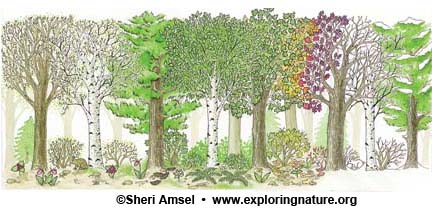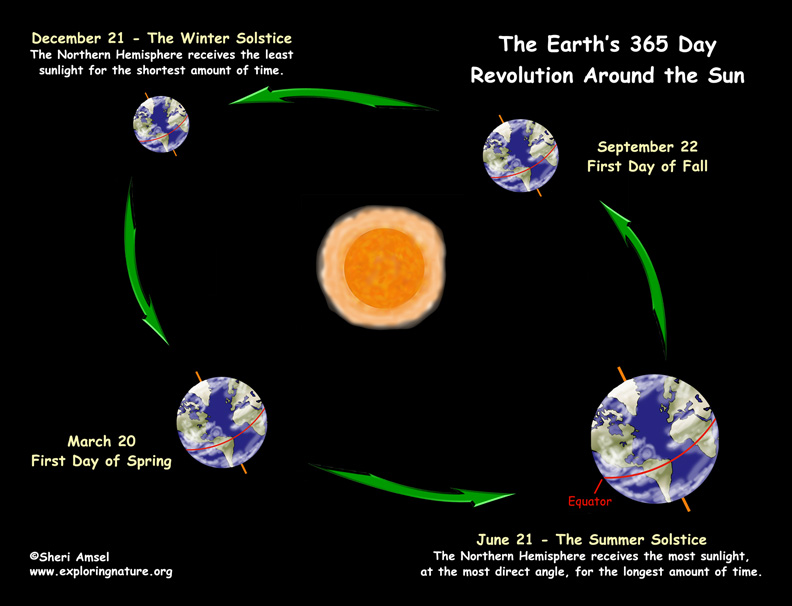

Our weather changes all year long – this is called the seasons. The seasons cycle from fall to winter to spring to summer every year. The seasons change because of two things – how much direct sunlight a place gets during the year and how long the sun shines on that place during the day (the day length). More details about sunlight and the changing seasons:
This day is called the summer solstice and is considered the first day of summer. In the Southern Hemisphere, it is the exact opposite! They experience the winter solstice on that day – the shortest day of the year.
The seasons are opposite in the Northern half of the world (Northern Hemisphere) than in the Southern half of the world (Southern Hemisphere). When we are swimming at the beach in the summer, the Southern half of the world (Southern Hemisphere) is sledding! The equator, shown as an imaginary red line around the middle of the Earth, divides the Northern Hemisphere from the Southern Hemisphere. North America is in the Northern Hemisphere.
Each changing season in our Northern Hemisphere has different weather. Let’s look at seasonal things.
Fall (Autumn)
Fall starts on September 22 every year. In the fall, the air starts to get colder every day. The noon sun starts to shine lower in the sky. Days grow shorter. Plants begin to lose their bright green color. They turn red or yellow or brown. Animals move south or get ready for winter sleep. Some animals grow warmer fur or feathers. Some animals change color to blend in with coming snow. For many animals this is mating season. The leaves of deciduous trees change color and fall off. In the Arctic, the sun no longer rises at all. For the next six months the Arctic will be dark.
Winter
Winter begins on December 21. The Northern half of the Earth (the Northern Hemisphere) is tilted away from the sun. This is our coldest season. The air can be freezing. It can snow. The wind is cold. The ground, roads and sidewalks can be icy. Many animals sleep (hibernate) to save energy. This helps them survive. It takes energy to stay warm in winter. Plus there are few plants to eat. After December 21st the sun is already beginning to climb higher in the sky. During the winter, the days are already slowly growing longer.
Spring
Spring begins on March 20. The days are longer. The sun is higher in the sky. The Northern half of the Earth (the Northern Hemisphere) is tilted toward the sun again. As the days grow longer, it gets warmer. Plants begin to bud and grow. Their life cycles begin again. Migrating animals move north and those who spent the winter in the north begin to shed their winter coats. Birds build nests. They find mates and start laying eggs. Mammals give birth to their young. Insects hatch and begin to feed.
Summer
Summer begins on June 21. Summer is the warmest season in the Northern half of the Earth (Northern Hemisphere). Plants grow. Plants are food for plant eating animals (herbivores). Animals gain weight and are food for meat eating animals (carnivores). Mammals and birds raise their babies. Insects mate and lay eggs. Summer is when all animals eat and gain weight. For humans, summer is the time to grow fresh food that we can eat all year. In early times, people ate only the fruits and vegetables they could store for winter. Now we bring fresh fruits and vegetables from the Southern half of the Earth (Southern Hemisphere) and tropical places, so we can eat them year round.
The length of day changes all year. That is because the Earth is tipped (23.5°) on its axis (see picture). If the Earth stood straight up and down, we would have 12 hours of day and 12 hours of night all year round, everywhere on Earth. Because of the Earth’s tilt, the Arctic in the far north, in the summer is tipped toward the sun. So from March 20th to September 22nd the sun never stops shining in the Arctic. Yet even though it gets sunlight for six months of the year, it is still not as hot as places nearer the equator. This is because the sun does not shine on the Arctic directly overhead, but at an angle.
You would think that the hottest day in the Northern half of the Earth (Northern Hemisphere) would on June 21st, but it really takes several weeks to warm the Earth. So it is usually July before we feel the warmest days. It also gets hotter all day as the sun “rises” in the sky. As with the seasons, even though the most direct sunlight is at noon, the day gets warmer and warmer until early in the afternoon.
The hottest place on record in North America is Death Valley, California, where it often reaches over 100° and once reached 134° F on July 10, 1913. The coldest place on record in North America is Prospect Creek, Alaska where it reached -80° F on January 23, 1971.
When you research information you must cite the reference. Citing for websites is different from citing from books, magazines and periodicals. The style of citing shown here is from the MLA Style Citations (Modern Language Association).
When citing a WEBSITE the general format is as follows.
Author Last Name, First Name(s). "Title: Subtitle of Part of Web Page, if appropriate." Title: Subtitle: Section of Page if appropriate. Sponsoring/Publishing Agency, If Given. Additional significant descriptive information. Date of Electronic Publication or other Date, such as Last Updated. Day Month Year of access < URL >.
Amsel, Sheri. "Changing Seasons" Exploring Nature Educational Resource ©2005-2024. December 13, 2024
< http://mail.exploringnature.org/db/view/1888 >


